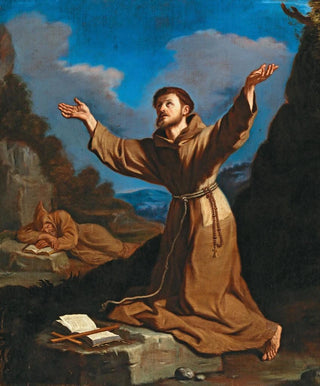Art print | Saint François recevant les stigmates - Guercino


View from behind

Frame (optional)
In the captivating world of Baroque art, the artwork "Saint Francis Receiving the Stigmata" by master Guercino stands out for its emotional intensity and spiritual depth. This canvas, created in the 17th century, depicts a pivotal moment in the life of Saint Francis of Assisi, where he receives the stigmata—a mystical experience that signifies his profound connection with the divine. Through this representation, Guercino manages to capture not only the essence of the saint but also the atmosphere of devotion and sacrifice surrounding him. The power of this piece lies in its ability to transport the viewer to a suspended moment, where faith and suffering converge.
Style and uniqueness of the artwork
Guercino's style in this piece is characterized by striking chiaroscuro, a technique that emphasizes contrasts between light and shadow. This approach gives the scene a particular dynamism, where the figures seem almost to emerge from darkness. The fine details of the drapery and facial expressions reveal impressive technical mastery, while the warm, earthy color palette enhances the spiritual atmosphere of the moment. The saint's gaze, full of fervor and pain, immediately draws attention, creating a strong emotional connection with the viewer. The composition, carefully balanced, guides the eye through the scene, inviting prolonged contemplation of the surrounding elements.
The artist and his influence
Guercino, whose real name is Giovanni Francesco Barbieri, is one of the most influential artists of the Italian Baroque period. Originating from Bologna, he established himself through his unique style and his ability to fuse realism with spirituality. Influenced by masters such as Caravaggio, Guercino developed a personal approach that is distinctly his own, blending a deep understanding of human emotions with refined pictorial technique. His artwork "Saint Francis Receiving the Stigmata" perfectly illustrates this duality. By emphasizing the vulnerability of the saint, he transcends the simple religious narrative to touch on universal themes such as suffering, faith, and redemption.

Matte finish

View from behind

Frame (optional)
In the captivating world of Baroque art, the artwork "Saint Francis Receiving the Stigmata" by master Guercino stands out for its emotional intensity and spiritual depth. This canvas, created in the 17th century, depicts a pivotal moment in the life of Saint Francis of Assisi, where he receives the stigmata—a mystical experience that signifies his profound connection with the divine. Through this representation, Guercino manages to capture not only the essence of the saint but also the atmosphere of devotion and sacrifice surrounding him. The power of this piece lies in its ability to transport the viewer to a suspended moment, where faith and suffering converge.
Style and uniqueness of the artwork
Guercino's style in this piece is characterized by striking chiaroscuro, a technique that emphasizes contrasts between light and shadow. This approach gives the scene a particular dynamism, where the figures seem almost to emerge from darkness. The fine details of the drapery and facial expressions reveal impressive technical mastery, while the warm, earthy color palette enhances the spiritual atmosphere of the moment. The saint's gaze, full of fervor and pain, immediately draws attention, creating a strong emotional connection with the viewer. The composition, carefully balanced, guides the eye through the scene, inviting prolonged contemplation of the surrounding elements.
The artist and his influence
Guercino, whose real name is Giovanni Francesco Barbieri, is one of the most influential artists of the Italian Baroque period. Originating from Bologna, he established himself through his unique style and his ability to fuse realism with spirituality. Influenced by masters such as Caravaggio, Guercino developed a personal approach that is distinctly his own, blending a deep understanding of human emotions with refined pictorial technique. His artwork "Saint Francis Receiving the Stigmata" perfectly illustrates this duality. By emphasizing the vulnerability of the saint, he transcends the simple religious narrative to touch on universal themes such as suffering, faith, and redemption.






